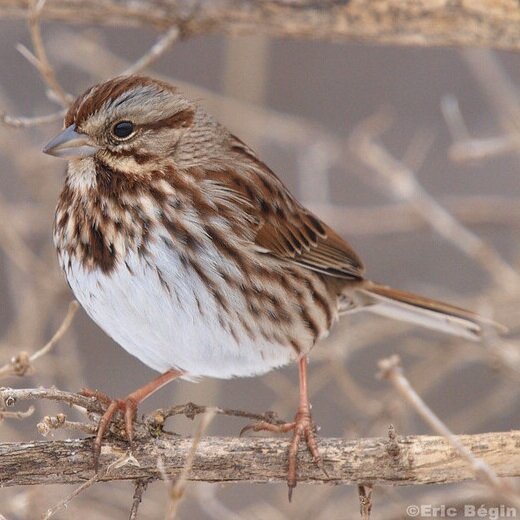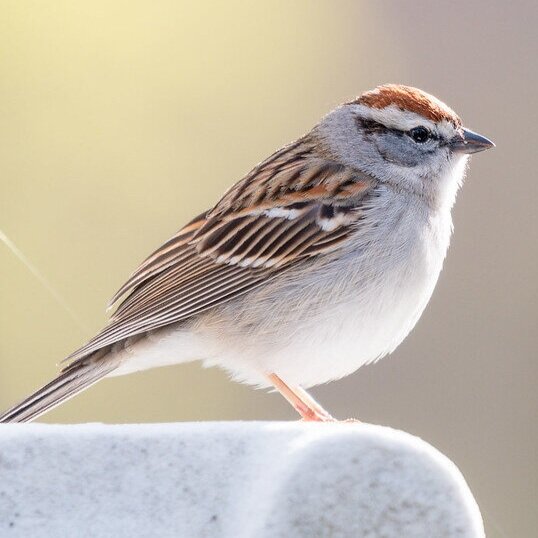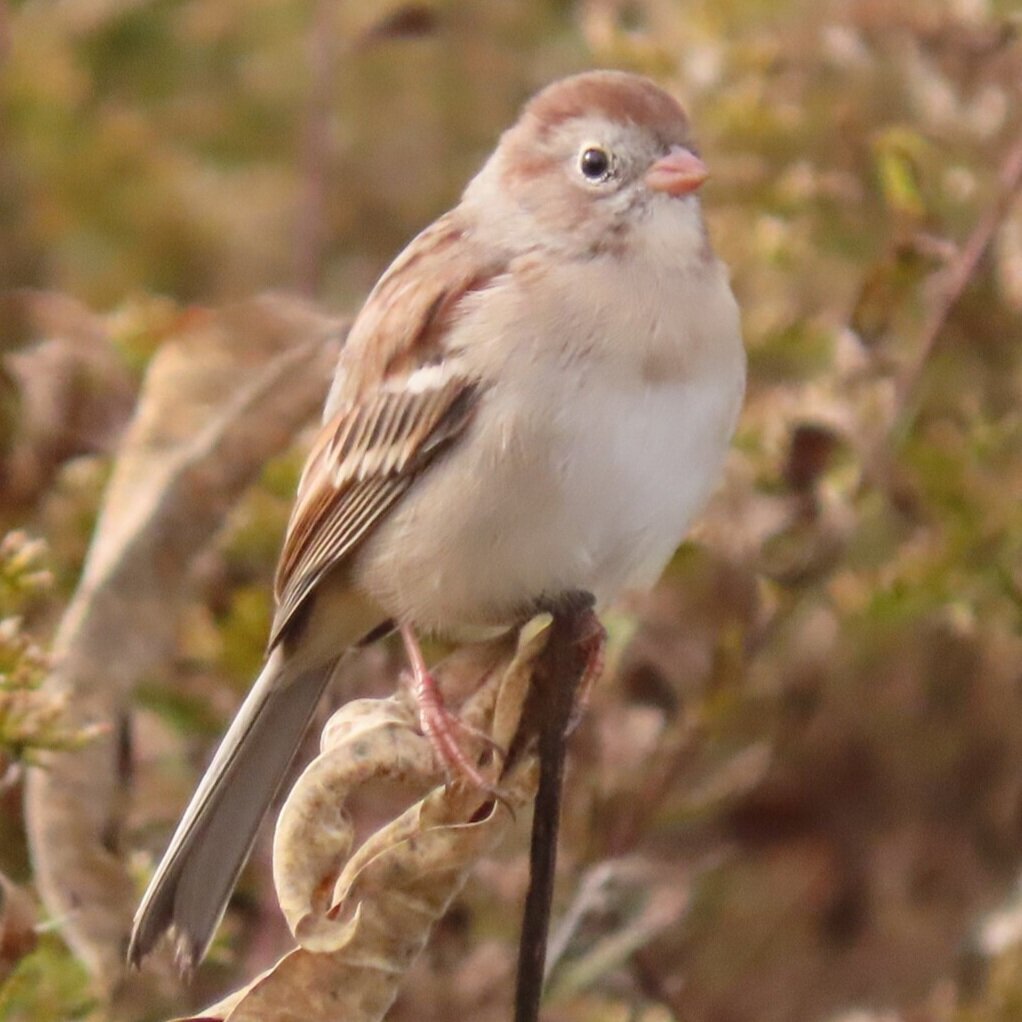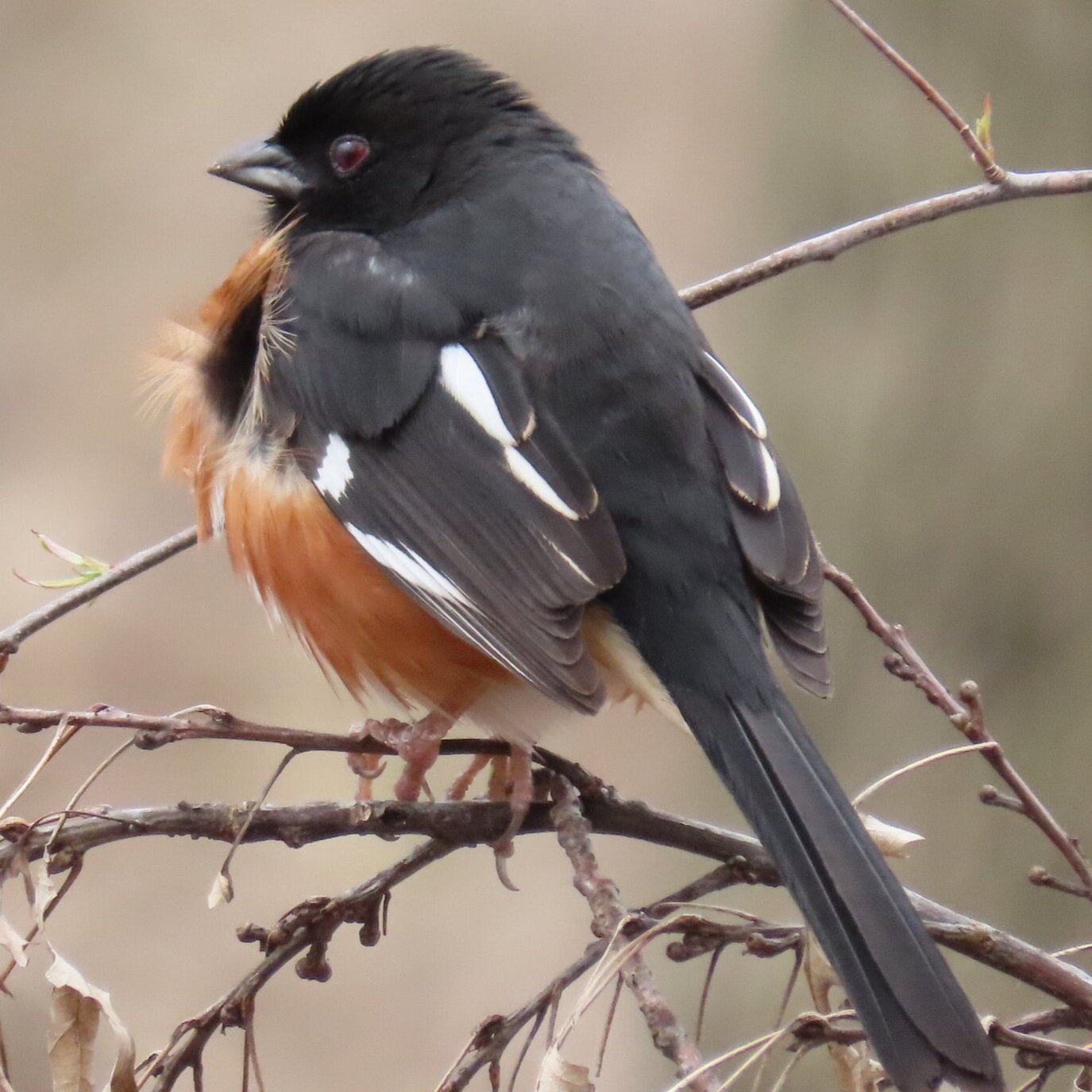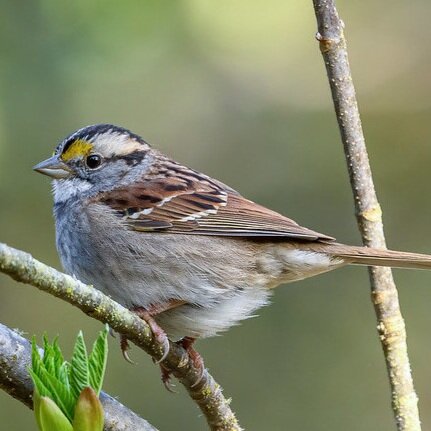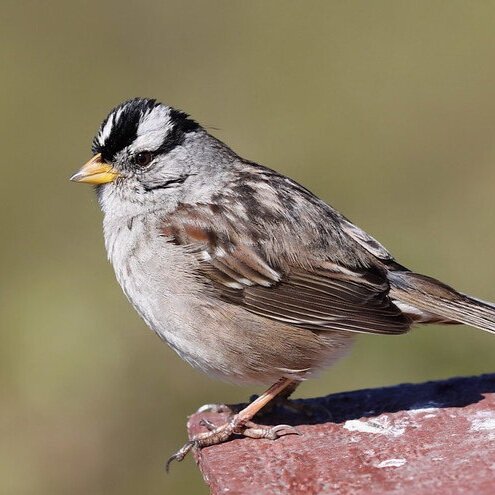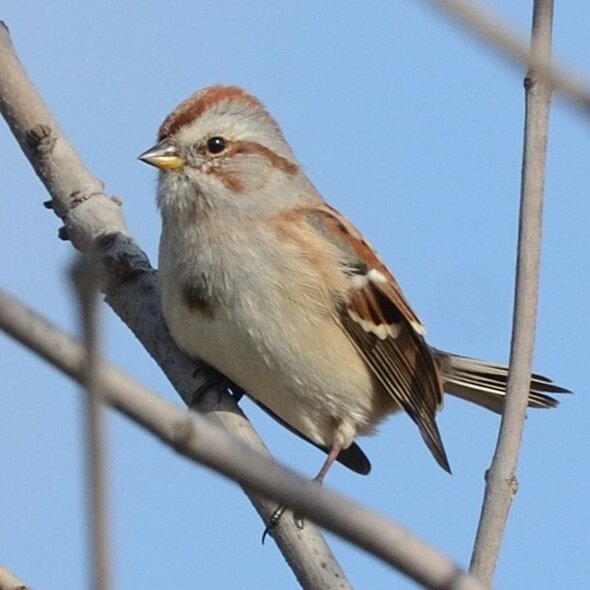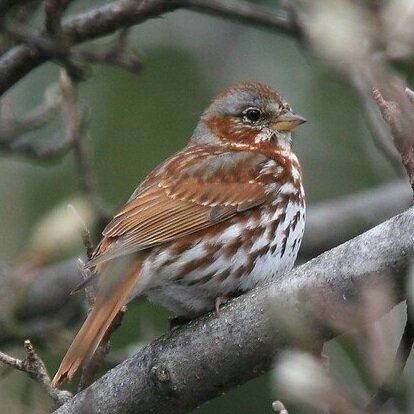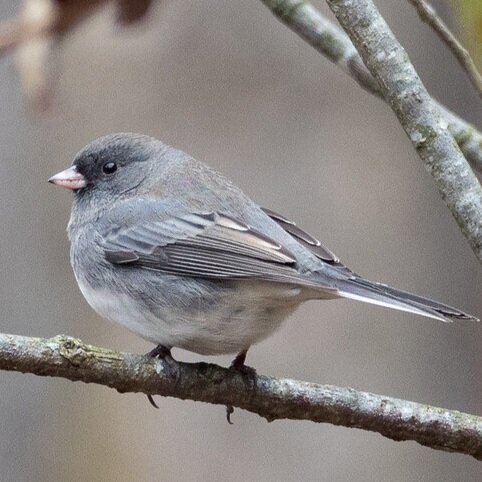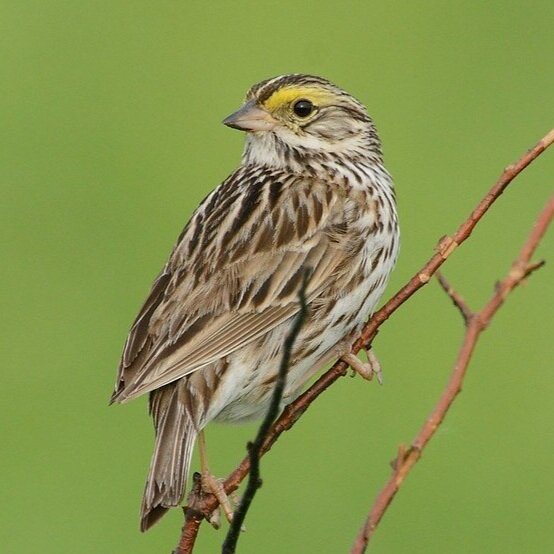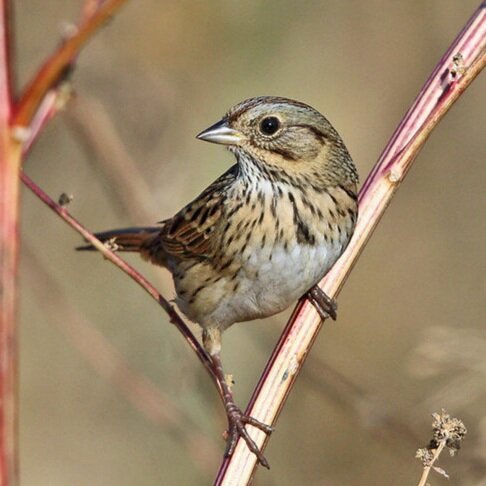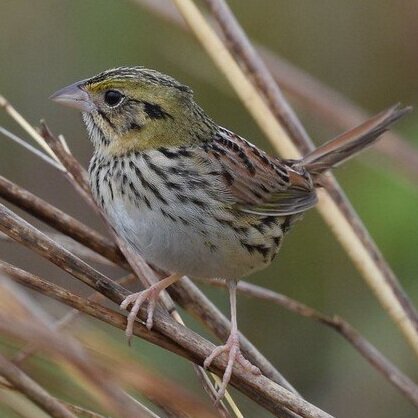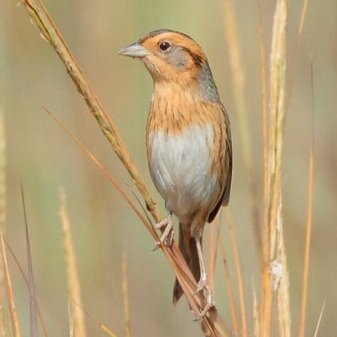October is here and it is already casting the world in a golden hue. Leaves are changing colors. Prairies are shifting to a sea of gold, red, and bronze. And fall migration is bringing us more “little brown birds” that camouflage themselves among it all.
Welcome to sparrow season. If you’ve been birding through the spring and summer, you’ve likely seen several species of sparrows already. Fall migration adds a few more sparrows to the mix, and October is the prime time to see some uncommon migrant sparrow species. It’s also when we’ll get an influx of our “winter” sparrows that will spend the next few months with us.
To the eyes of a new birder, sparrows can look frustratingly similar. Brown, small, streaky, and often elusive. Not only are they well-camouflaged and tough to spot, they often dive into the low, thick grass or brush before you can even get a glimpse. But patience and perseverance and some good ol’ slow birding can be your friend. This week’s Entryway to Birding blog brings you tips for sorting out sparrows, techniques for how to find them, a few recommendations of places to go.
A LeConte’s sparrow perches low in the grass. I spent several patient hours this weekend looking for a couple of LeConte’s sparrows that are hanging out at Smith-Reiner Drumlin Prairie, a gorgeous site managed by The Prairie Enthusiasts. While I was able to get good-but-quick looks at two LeConte’s sparrows throughout the morning, I hadn’t managed to get a photo of this elusive bird. I was about to leave when I decided to give it one more shot—and I was so glad I did. Photo by Caitlyn Schuchhardt
Sparrow Round Up
So who are all the “little brown jobs” you’ll be sorting through? I’m going to break down some of the sparrows you can see into a few loose groups. This isn’t a comprehensive list, but it will hopefully help you get a better handle on your sparrows and learn about some key field marks that might distinguish them from each other. For a more comprehensive look at what sparrows you can find in our region and when, give eBird’s bar charts feature a whirl.
Common sparrows that have been around this summer and fall:
Photos by Eric Begin (song sparrow), Tim Sackton (chipping sparrow), Caitlyn Schuchhardt (field sparrow and eastern towhee)
Song sparrows have that classic “brown and streaky” look to them, but the biggest thing to notice about their plumage is the blotchy patch in the middle of their chest. These birds are often easy to spot, since they tend to perch out in the open and give you good looks. I feel like they are a curious bird—even if they do dart into some brush when you approach, they often will pop up to get a better look at you.
Chipping sparrows are best recognized by their rufousy-red cap, clean gray breast, and strong, dark eyeline—there is a line of dark feathers that runs from their bill, straight through their eye and across the side of their head. Other birds may have an eyeline too, but it’s often not as dark or sharp as you’ll see on a “chippy.” I tend to see this species mixed in with other sparrow flocks, foraging on the brushy edges of paths.
Field sparrows are one of my favorite sparrows. Their pink bills and pale buffy coloring without a lot of other markings gives them a very clean look. I personally think they have a bit of a baby face, but I don’t think you’ll find “adorable” listed as a field mark in your Sibley’s guide.
Eastern towhees are sparrows! I did not know this for an embarrassingly long time, even though I know I’ve looked at them in my field guide. They look quite different from the assumed, generic “small brown bird” and are bulkier in size, but they are indeed sparrows—quite flashy ones with their black, rufous, and white plumage. They tend to be solitary, hiding low in brush, kicking up leaf litter.
Newly arriving this fall, some “winter” sparrows:
Photos by Becky Matsubura (white-throated), Aaron Maizlish (white-crowned), Tom Murray (American tree sparrow), Dominic Sherony (fox sparrow) ,Shawn Taylor (dark-eyed junco)
White-throated sparrows just recently started arriving in the last few weeks. Their name is accurate—keep an eye out for that white throat! Some birds will have a very sharp, crisp looking white beard, but others may not be as defined. Another key thing to look for is a bit of yellow at the lores (the feathers in that space between the eye and bill).
White-crowned sparrows are another newly arrived bird this season. They have distinct stripes on their head—you might see an adult with the classic white and black stripes, or you might see an immature bird with gray and brown stripes. Either way, these stripes are broader and thicker than you’ll see on other sparrows. I notice that white-crowned sparrows tend to keep their head feathers slightly crested, which makes their heads look big and bulky, almost like they are wearing an actual crown.
American tree sparrows will be here soon, ready to spend the winter with us. I really like these little guys, because they have a nice, easy field mark—a single dot in the middle of their chest. If they refuse to turn around and show you their chest, try and get a glimpse of their unique bi-colored bill—the top part is gray and the bottom of the bill is orange!
Fox sparrows stand out among sparrows with their dark, reddish-brown color and larger size. Look for triangular shaped markings that form streaks down their chest. These birds prefer really dense, brushy patches and are often solitary. They like to kick through leaf litter too.
Dark-eyed juncos, a winter favorite! These birds have already arrived this fall and you’ll see them all winter. Slate gray and sometimes featuring a slightly buffy and cream-colored belly, they will often forage along the ground. If they flush as you approach, look for a flash of white on either side of their tail feathers—no other sparrow will flash that white on the tail!
Not-So-Common to Rare Sparrows:
Photos by Janet and Phil (savanna), Tom Murray (Lincoln’s), Andy Reago & Chrissy McClarren (Henslow’s), Julio Mulero (Nelson’s), Frank D. Lospalluto (LeConte’s)
Savanna sparrows are sparrows you’ll likely see if you are birding in open fields or grassy, weedy areas, not hidden in thick brush like some more skulkier sparrows—these ones will perch for you! I don’t tend to see savanna sparrows when I’m birding in areas in town; I see them more when I get outside of the city into some good, wide-open prairie. These birds look similar to song sparrows, but are more crisply streaked and often have a bit of yellow on their lores (by their eye).
Lincoln’s sparrows are a migrant sparrow you might catch a glimpse of this October. I’ve seen one or two around natural areas or conservation parks in town, but you won’t see them in big numbers like you might song sparrows. They too are another characteristically “brown and streaky” bird, but their streaks are much finer and more delicate than those of the song sparrow, which it may sometimes get confused for. If a song sparrow had its streaks drawn on in crayon, a Lincoln’s sparrow would have its streaks drawn on in pencil. They also have a noticeable “buffy wash” on their upperparts, which a song sparrow lacks.
Henslow’s sparrows are a sparrow population in decline, but they are summer, nesting residents here in our region! You aren’t too likely to see them at this time in the fall, though, as they will be leaving during migration. If you do spot a late one lingering while you’re out birding a tallgrass prairie (their preferred habitat), look for it’s larger head and heavy bill, and a narrow band of thin streaks across a buffy chest.
Nelson’s sparrows are a sparrow that prefer a more marshy, wet prairie habitat than some other sparrows. They’ve got a boldly patterned gray and orange face with a gray crown, gray cheek patch, and gray nape. Their chest will show an orange wash on top with some light streaks and a well-defined white belly. These are “rare” birds in that they are infrequent visitors only during migration, but now is your time to see them! (Suggestions for where to find them are at the end of this post.)
LeConte’s sparrows are in the same family as Nelson’s sparrows and are also very bright and orange-ish in their coloring. They can look similar because of this, but they lack the strong demarcation between the orange and white on their chest and have a more yellow-ish buff there instead. They’ll have a small gray triangle-shaped patch below their eye with a dark eyeline and a thin crown stripe. They also tend to be much more elusive and skulky, preferring to hang low in thick grasses. These are another “rare” bird that are infrequent visitors during migration, and October is your best time to see them too. (Suggestions for where to find them are at the end of this post.)
This is not all the sparrows you can find in south-central Wisconsin, but it hopefully gives you an idea of the immense diversity you can see among these birds that are often cast in shades of drab, boring brown. They are far from drab and far from just “brown”—from their deep rufous reds to buffy, pale yellows, to oranges and blacks and all the shades of deep, warm brown in-between, these birds are a kaleidoscope of nature’s warmest, earthy colors. Give them more than just a glance—give them a good, appreciative look. (If they’ll let you, that is!)
Search smarter (and slower)
Sparrows can be a frustrating bird to go searching for because once they flush, they’ll often hide deep in the brush or tall grasses, just out of your sight. If you’re lucky, a curious fellow will poke up long enough for you to get a good look, but that’s not always the case. They reward patience and a slow approach.
Here are four tips to help you if you find yourself continually eluded by sparrows:
Tip 1: Scan the path and area far ahead of you.
Look at all those good edges where sparrows might be hanging! I flushed more than a few that were foraging along the edge when I walked this path at Waunakee Marsh SWA. Photo by Caitlyn Schuchhardt
One thing that I’ve noticed is that sparrows are often right in front of me, perfectly in view, but I simply don’t see them until I’m right up on them and they flush, darting into the brush or thick grasses before I can get a good look at them.
If you are walking along a path lined with grasses, brush, or weedy edges, be sure to scan far ahead of you before you start moving closer. You might see sparrows foraging on the ground or darting about before they’ve noticed you. You can then try to slowly approach and see if you can get a closer look.
Tip 2: Get adjusted to the scenery and habitat.
This is a tip that applies in any birding situation, but can help you with sparrows especially. Spend some time just scanning the plant life, the grasses, the brush, wherever you are. Let your eyes adjust to the particularities of the habitat you’re in and get a feel for all the natural movement around you—the wind through the grass, the falling leaves, the slight sway of branches. When you do see a quick burst of movement—even the brief darting of a sparrow from one clump of big bluestem to the next—your eyes will be much faster to catch it.
Tip 3: See something dive into the brush? Do NOT take your eyes off the spot it disappeared into.
Keep your eyes on where the bird landed. Do your best to not look away, unless there is a very obvious or clear marker nearby that you can use to refind the spot. I guarantee the moment you take your eyes off the spot, one of two things will happen: the bird will up and move away again and you won’t get a good look at where it landed next, effectively losing it entirely, or you’ll look back and be unsure of where you were looking before, leading to a lot of uncertainty as to where you should focus your attention.
There is a bird in this picture, I swear! This was my first photo attempt of an immature LeConte’s near Stoughton a few weeks ago—this blurry view was the best I got, but notice how a few field marks are visible, like the orange face, the crown stripe and hint of eyeline, with a pale chest. Photo by Caitlyn Schuchhardt
With your eyes still focused on that spot, raise your binoculars and look—very carefully. Be prepared to play around with the focus. You’ll likely be staring straight into some thick brush, and the focusing knob on your binoculars can help you get a “deeper” look into the brush. You’ll notice that as you focus with your binoculars on sections of vegetation further back, the grasses or thin branches in the foreground will get “blurred out” and you can effectively get a blurry-but-workable view right through them. If you’re lucky, you might get a partial glimpse of a bird tucked deep in there and maybe spot a field mark or two.
Sometimes you won’t be lucky and simply can’t refind it. Don’t let it get to you—it is okay if most of those super skulky, elusive sparrows go unidentified. It just makes the ones that you can get good looks at even more satisfying.
Tip 4: Be a stealthy sparrow stalker.
If you are out in an area where you can wander freely, unconstrained by the limits of a trail, you might even try stalking that sparrow through the field. Slowly approach the area you saw it land, keeping on the lookout for any quick movement that could be the bird hopping or flushing low through the brush. Your best chances at getting a really good look are just after you flush the bird and as it (potentially) re-lands nearby, hopefully a little more visible than it was before.
This takes patience and likely many repeated attempts, but I guarantee it is a ton of fun. “Putting in the work” for your sighting like this can be fun, memorable, and lead to even more appreciation for the wonder of these fascinating, often overlooked birds.
Note: Not all places you visit allow off-trail activity like this, so be aware of the property’s rules. This is a big no at conservation parks or places like the UW-Arboretum, where trails are there to keep you off protected vegetation. If you want to frolic freely among the prairies as you sparrow search, we’d love for you to visit Madison Audubon’s Goose Pond Sanctuary or Faville Grove Sanctuary, both sites where open exploration is encouraged. State natural areas or state wildlife areas can also be great for this, but make sure you go prepared this time of year!
There’s plenty of room to roam at Goose Pond Sanctuary. I took this photo a few weeks ago at Browne Prairie, and I’m sure the prairie colors are already starting to shift. Go check it out! I’ve heard there are some rare sparrows waiting for you—seriously! Photo by Caitlyn Schuchhardt
Where To Go Sparrowing*
*I don’t think this is a real word, but I certainly propose making it one.
You can find the more common sparrow species around town, but if you’d like to go in search of the exciting Nelson’s and LeConte’s that are migrating through in October, I’ve got a few recommended places for you to check out. In the process, you’ll see some gorgeous prairies and wetlands.
Nelson’s sparrows are enjoying this wet, marshy landscape at Lake Barney. Photo by Caitlyn Schuchhardt
Nelson’s sparrows are being seen out at Lake Barney near Fitchburg and also up at Madison Audubon’s Goose Pond Sanctuary. If you visit Lake Barney (directions here), be sure to don some orange—it is a popular spot for waterfowl hunting. Park on the shoulder off Caine Rd, then cross M to a path that runs along a fence. Walk down to the water and focus your search on the vegetation that borders the shore. At Goose Pond, Nelson’s sparrows have been reported near the kiosk at Prairie Lane (directions here). Focus your search along there, but take care to not walk down to the pond. You can explore the prairie opposite the pond all you’d like though! I saw some eBird reports come in recently too that reported more Nelson’s sparrows over near Browne Prairie, so make a day of it and do some exploring!
A gorgeous fall prairie will greet you at Smith-Reiner Drumlin. Photo by Caitlyn Schuchhardt
LeConte’s sparrows are being seen at Smith-Reiner Drumlin Prairie (directions here) and also up at Faville Grove Sanctuary (directions here). Read about our sanctuary steward, Drew’s, sighting at Charles Prairie at Faville in our recent Friday Feathered Feature! At Smith-Reiner Drumlin, walk the access lane to the property and focus your search on the northernmost part of the property, particularly at the corner where the path turns to run along the drumlin.
Autumn is the perfect time to go meandering through the prairies looking for sparrows. The time I spent at Smith-Reiner Drumlin Prairie this weekend was the highlight of my week—I felt rejuvenated by the weather, the birding friends I ran into along the way, the gorgeous landscape, and the thrill of chasing and finding an elusive bird.
I started a phenology journal after getting inspired by my colleagues Carolyn and Brenna in this Madison Audubon video. I highly recommend it—there are so many changes to document this time of year! Photo by Caitlyn Schuchhardt
It was so perfect I didn’t want to leave—so I didn’t. I found the perfect rock to perch on as the sun warmed my back and the breeze rustled through the grasses around me, and took some time to sketch in my phenology journal.
I encourage you to make a day of your sparrow search—be patient, be curious, be willing to explore, be awed the changing autumn world around you and the transience of these fall migrants. Even if you don’t find a sparrow, I guarantee you won’t regret the time you’ve spent searching.
Happy sparrowing, everyone!
______
Caitlyn is the Communications and Outreach Assistant at Madison Audubon. She’s crazy for birds because they changed her life. She’ll be back next Monday with some tips and tools for birders, new and experienced! Between now and then, she’d love to hear about the birds you’re seeing and hearing. Leave a comment below or email to drop her a line!



